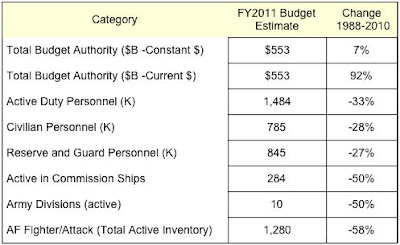1. Increased spending from 1988 through 2010 supported less active duty personnel, fewer reserves, fewer ships, less Army divisions and a smaller number of fighters (SOURCE: National Defense Budget Estimate for FY2011 as of April 2010):
Conclusion: Spending more bought substantially less.
2. 40% of active duty personnel were never deployed. 11.4% was deployed three or more times. 339,142 active duty personnel, costing on the average $160,000/year were performing commercial (not war fighting-related) activities.
Conclusion: A small number of active duty personnel do most of the fighting. Commercial work was performed by active duty personnel costing $54 billion.
3. There has been a steady rise in non-payroll costs for DoD personnel. In FY10 this accounted for $22.5 Billion such as for TRICARE, family separation allowances and survivor benefits. Total retiree outlays for military personnel were $46.7 Billion in FY10.
Conclusion: The trend of rising non-payroll costs will reduce the amount of money available for active duty and civilian personnel.
4. The Federal Deficits, as a % of GDP, can be expected to increase from 9.9% for FY2009 to 24% in FY2040 if present trends continue without change. (SOURCE: Peterson Foundation – A Citizen Guide April 2010).
Conclusion: A 24% share of the GDP deficit is unlikely to be sustainable.
5. The FY 2010 $3.5 Trillion Federal Budget, in constant 2009 $s, will allocate 40% for Social Security & Medicare; 6% for net interest; 34% for all other and 20% for Defense. The FY 2040 $12.3 Trillion Federal Budget, in constant 2009 $s, will allocate 52% of to Social Security & Medicare; 30% to net interest and 7% to all other. Only 11% of the Federal Budget would be available for Defense (SOURCE: Peterson Foundation – A Citizen Guide April 2010).
Conclusion: If the Federal Budget, in 2040 $s is $12.3 Trillion, it would support $1.4 Trillion for Defense, or double the current FY 2010 budget. However, the rise in non-payroll costs is likely to absorb most of Defense budget increases over a thirty-year period.
6. DoD overhead costs, which are concentrated in Administration, Logistics, Finance and HR systems, have an estimated total cost of about $212 Billion. This is approximately 40% of the total DoD budget (SOURCE: Slide 16 of Defense Business Board report).
Conclusion: Information technology should be considered as a premier tool for reducing overhead costs by means of systems simplification and through business process improvement.
Summary:
The costs of DoD information technologies for FY10 are $33.7 Billion for O&M costs plus compensation of an estimated number >200,000 of military and civilian personnel at an average cost of $130,000/year (approximately $26 Billion). This represents about 10% of the total DoD FY10 budget.
Since information technology is deflating at a rate that is greater that 15% it offers an attractive opportunities for cost reductions. If information technology is also applied to business process redesign the resultant manpower O&M savings can be even greater than what can be accomplished by cuts in technology spending.

No comments:
Post a Comment
For comments please e-mail paul@strassmann.com